Circular error probability (CEP) is the metric weapons designers use to describe the accuracy of munitions. CEP is defined as the radius of a circle, centered on the intended target, within which 50% of projectiles or warheads are expected to land. As guidance technology has advanced, CEPs of modern missiles and drones have grown smaller. I will describe this evolution, its relevance to the current Mideast conflict, and its long-term consequences.
The grim technology of weaponry is full of engineering tradeoffs. For most of the history of of gunpowder and high explosive armament, the path to increasing the effectiveness of weapons has been scaling up their explosive power and rate of delivery in order to overcome limits to accuracy. The larger the explosive bomb or shell, the greater the radius of damage it can inflict. The higher the rate of fire of a gun or gun battery, the more chances that a projectile will hit a target. Since WWII, this tradeoff has changed to substituting increased accuracy for explosive power and rate of fire. This has the advantages of reducing the number of projectiles needed to destroy a target and minimizing collateral damage.
It is a macabre fact that the first effective guided missiles were the Japanese Kamikaze aircraft. Japanese pilots, at the cost of their lives, inflicted massive damage on U.S. Navy forces in the last years of WWII. There had been experimental attempts at radio control of German anti-aircraft rockets in WWII, but these were never deployed. Both Germany and the U.S. deployed crude guided glide bombs (Hs 293 and ASM-N-2 Bat) and used them to sink a few ships, but these weapons had little effect on the war. The German V2, the first ballistic missile, had an early inertial guidance system that delivered poor accuracy (17 Km CEP).
German WWII HS-293 radio guided anti-ship glide bomb
In the decades since WWII, great improvements have occurred in missile accuracy, mainly because of the rapid development of advanced electronics. Today, there are many technology choices for precision guidance of weapons. Medium range missiles can now theoretically achieve a 10 meter CEP, which is sufficient to destroy almost any fixed target. Short-range drones and missiles are even more accurate. Moving targets pose a greater challenge to guided weapons because they generally require a skilled human operator to guide them, but advances in machine vision promise to enable autonomous drones and missiles that can identify and effectively attack vehicles and other moving targets without human intervention.
The vast defense expenditures of global superpowers funded the development of increasingly sophisticated precision guided munitions (PGM). This technology has proliferated to smaller nations, and it is now on center stage in the current hostilities between Israel and Iran. Israel has used air-launched PGMs to strike at hundreds of targets in Iran, and Iran has responded with ballistic missiles accurate enough to inflict substantial damage on major Israeli cities. The Iranian missiles have shattered Israel’s reputation of possessing impregnable defenses, and this will likely encourage other Mideast nations to build substantial missile arsenals. The era of Israel’s military dominance in the region may be approaching an end.
Missile strike aftermath in Tel Aviv
Enter BeiDou
One of the best means of guiding long-range PGMs to fixed targets is satellite navigation. It operates in any weather conditions and requires only a satellite link in the missile and a relatively simple control system. Like the U.S., Russia and China have developed and deployed satellite navigation systems for both civilian and military use. In 2015, Iran’s electronics firm Salran signed agreements with Chinese counterparts to integrate BeiDou satellite navigation into Iranian missiles and UAVs. By 2021, Iran had reportedly been granted full military access to China’s BeiDou system. Recent Iranian MRBMs, such as Kheibar Shekan, feature maneuverable re-entry vehicles with satellite navigation systems, indicating use of BeiDou for mid-course and terminal guidance. This is what enables a CEP of under 30 meters for the most accurate Iranian ballistic missiles.
Growing Risks
Every nation has vital infrastructure that is poorly protected against missile attack. The advent of mass-produced precision missiles and drones creates new opportunities for asymmetric warfare. Small nations no longer need large and costly aerial armadas to conduct powerful strikes against regional adversaries. Missile arsenals require lower operating costs and fewer highly trained personnel than aircraft fleets. Drones and small missiles are effective weapons for clandestine operations inside enemy territory. They are easily smuggled and highly effective, as evidenced by Israeli decapitation strikes in Iran and Ukrainian attacks on Russian airbases. As these weapons become available to criminals and terrorists, precision guided drones will make the world more dangerous.
Israeli assassination strike with PGM
Conclusion
The widespread proliferation of highly accurate, precision-guided missiles and drones is inevitable, and it will create serious challenges to world peace. Asymetric warfare and regional conflicts are likely to become more destructive as PGMs deliver devastating blows to critical infrastructure, military targets, and leadership personnel. The U.S. has opened a Pandora’s box of violence by funding and arming fractious groups around the world, and these groups will increasingly utilize PGMs, some of which may end up aimed at the U.S. A new generation of arms control treaties and export restrictions is called for in order to curtail this threat. As CEPs get smaller the danger to the world grows larger, and that is precisely the problem.
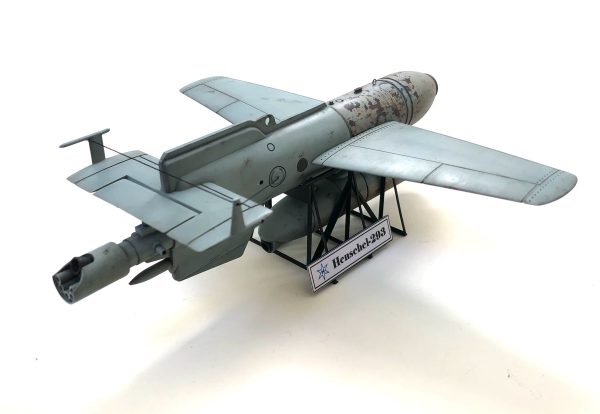
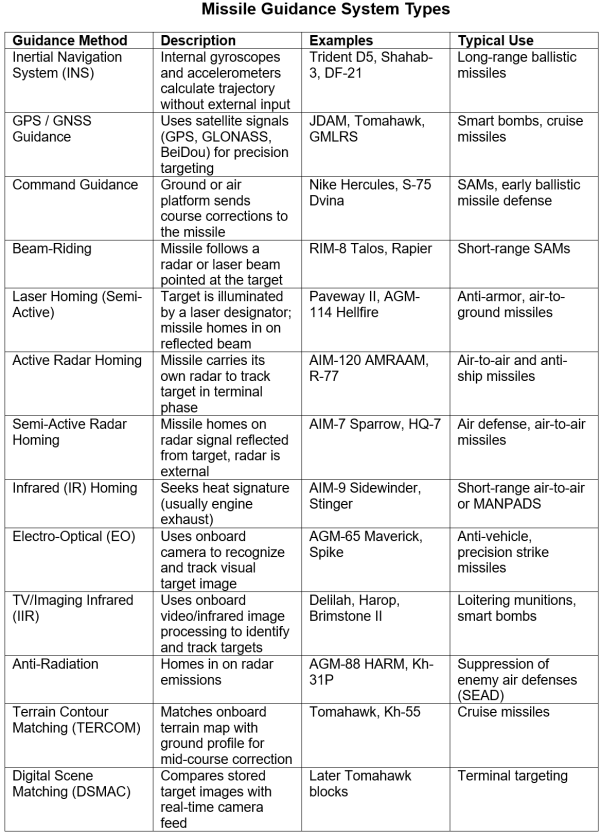
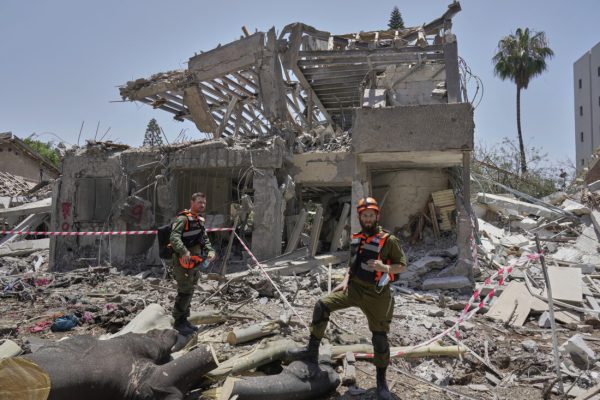
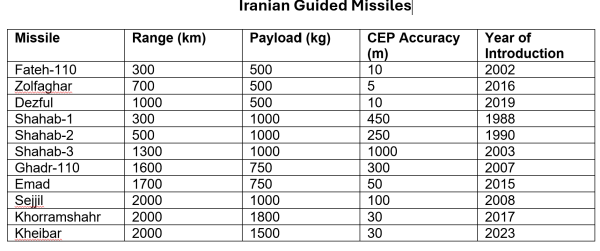
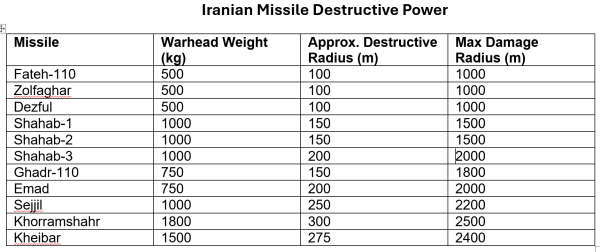
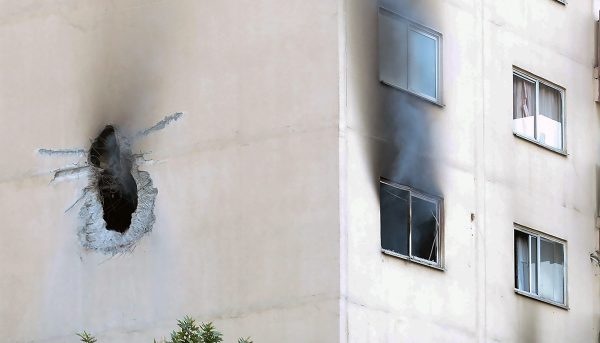


Your discussion focuses on ground and air weaponry, but the table on “missile guidance systems” could be completed with one technique that is very much used in sea warfare: acoustic homed missiles — which at sea means acoustic homed torpedoes.
I am not sure whether acoustic homed anti-aircraft missiles have been experimented with in the past. In any case, sea warfare is relevant, with Ukraine having used, sometimes quite successfully, drones against the Russian fleet, although I believe those were of the remote-controlled kind.
Does it matter that sonic guidance is limited by the speed of sound? Torpedoes are slow, missiles fast.
So good against zeppelins?
Anyway: Ukraine shows that advanced techniques are also being applied to sea warfare. Ansarallah made the Red Sea a theatre of surface operations, Hezbollah did inflict damages to the Israeli navy in 2006, and everybody has been speculating about what would happen in the Persian Gulf should a full-scale war erupt. Hence, missile guidance systems in water are relevant too.
Zeppelins or slow subsonic aircraft such as drones.
Passive sound detection (or to be precise, vibration monitoring) can be used to locate and target artillery, and can also be used to trigger mines, which can use sound/vibration to distinguish between a heavy military vehicle and a smaller civilian one. But its used as part of initial identification, not terminal guidance. Sonar would be too slow for missile guidance.
Arguably, the first true smart weapons were active and passive sonar torpedoes first used in WWII. There are also Soviet wake riding torpedoes, that detect the change in wave pattern from large vessels and can use that for guidance. And lets not forget those experiments with using dogs (Soviet anti-tank units), pigeons and bats (the US) and dolphins (various). Famously, the Soviet dogs turned out to only go for diesel powered Soviet tanks, and the incendiary bats the US experimented with in WWII turned out to be too fond of homing in on the wrong attics.
Modern radars are getting increasingly good at detecting small drones – some now use doppler to detect moving propellors to allow them to distinguish small drones from birds or towed decoys. I suspect the most effective anti-drone devices will turn out to be old fashioned explosive shells, just with much more accurate detection and aiming.
Another form of terminal guidance that will become much more important I think is ARM which home in on active jammers. The US has already developed modular homing add-ons to existing missiles that allow missiles to aim specifically at GPS jammers.
Unless Israel makes radical short order changes in its expansionist policy regarding its neighbors, advances in weapons accuracy represent a real existential threat- unlike that posed by Iran.
The same is true of the US & of regional hegemons. The rational response is to make peace with the reality that we are living in an age of limits, resource, ecological/climactic, economic, and the existence of around 12-14,000 nukes, and negotiate an equitable sharing arrangement. Diogenes is still looking hard.
One thing that’s worth remebering is that Israelis likely learned about using special ops teams with ATGMs from Hizb’ullah: they were doing exactly that against Israeli military installations in N Israel–radar sites and such. So “arned groups” were already in on the trick, at least on this method.
This sort of tactic goes back probably to the Stern Gang. One trick they used to use (which in turn was copied by the PLO later on), was to aim in mortars onto a target, then cover and disguise the mortar with rocks or other camouflage. Then, days or weeks later, at a time of their choosing, someone unarmed could simply uncover the mortar (still dialed in on the target), and let off a few rounds.
I strongly suspect that most of those attacks in Iran were done remotely – the special ops teams were already home when they were set off.
I understood that the Internet in Iran went down precisely to prevent Israeli operatives from remote controlling the devices they had planted. Of course, Iran has also claimed (and presented) to have captured over hundred Mossad agents by now, most apparently being Afghans.
What am I looking at in that butt-hole like picture?
Benjamin Netanyahu farted.
I think it’s from the start of Israeli attack on Iran. Some sort of guided munition supposedly attacked an appartment of someone important. The lines are probably from the wings that broke off. Why the bulding did not suffer more sever damage, is anyone’s guess.
In the start of Israel’s attack on Iran they used in country spies to attack many iranian targets with small drones and small guided missiles. Thats the entry hole for one of them.
I wonder electronic warfare will affect these sorts of munitions. I seem to recall Ukrainians complaining that all these American guided munitions were more or less ineffective due to Russian jamming and electronic warfare
Yes, and yes. Russians use increasingly complex antenna array on their ordnance in order to improve jamming resistance.
leaf: ….Ukrainians complaining that all these American guided munitions were more or less ineffective due to Russian jamming and electronic warfare
Yes, of course. The major point here is that EW advances in turn breed and will breed countermeasures. Inevitably, these will include autonomous AI weapons, both aerial and ground drones, and precision-guided AI munitions.
This will be an increasing trend. God help us.
After all, the US emphasis on netwar, radio-linked network systems, and GPS guidance has been promoted since Andy Marshall was still running the Pentagon’s Office of Net Assessment*. The major powers — Russia, notably — have had time to develop countermeasures.
In fact, Chinese and Russian military thinkers studied Marshall’s thinking from at least the late 1980s onwards, taking him more seriously than anyone in the US does now.**
https://en.wikipedia.org/wiki/Andrew_Marshall_(foreign_policy_strategist)
* Marshall ran Pentagon strategy essentially from1973 to 2015 and among other things was, forex, the figure who decided to put ballistic missile guidance systems on bombs (JDAMs) in time for Gulf One in 1991, to put GPS on everything, and ordered a study of climate change risk in 2003 to try and wake Washington up.
An Abrupt Climate Change Scenario and its Implications for United States National Security
** In a meeting with The Economist at the Academy, General Chen Zhou, the main author of the four most recent defence white papers, said: “We studied RMA exhaustively. Our great hero was Andy Marshall in the Pentagon [the powerful head of the Office of Net Assessment who was known as the Pentagon’s futurist-in-chief]. We translated every word he wrote.”
https://archive.ph/8o6kj
And yet most people in the West are still ready to uncritically believe in the magical power of American technology. Look at the story that’s being spread about Fordow. Six holes visible in the landscape, 12 MOPs claimed dropped, therefore, so the story goes, they must have successfully dropped six bombs into the holes left by six previous bombs. That story implies centimetre-level CEP, a level of capability not exactly well attested to by the performance of GPS-guided Western weaponry in Ukraine. To me, a fishy story, but the majority seem to have no doubt that it’s within American capabilities.
In the next Top Gun movie, Tom Cruise will fly into one ot those holes. Then, come out of another, holding an Iranian nuclear scientist between his teeth.
Same radio control system was used on Hs 293 (rocket propelled), Fritz X (regular glide bomb), and Hs 298 (air-to-air that never was).
https://en.wikipedia.org/wiki/Kehl-Strasbourg_radio_control_link
There was also an attempt at wire-guided air-to-air.
https://en.wikipedia.org/wiki/Ruhrstahl_X-4
Looks like the range of newer missiles and drones may make warfare more ‘democratic.’ In the past Washington might have thought about invading a country like Venezuela and know that, like in Vietnam, jungle warfare would have to come back into vogue. They would just brute force their way in like they did in Iraq. But now? The cost would be far too exorbitant in terms of men and material. Drones would take out the tanks, artillery and all the other systems that the US uses in accordance with their doctrine. Ordinary soldiers would be hunted down by small killer drones and it would make the fighting of the occupation of Iraq look quaint. Add to that ballistic missiles that could target logistics bases and suddenly the calculations for invading and occupying foreign countries no longer look so attractive. So maybe this is why there are so many attempts at colour revolutions and NGOs and the like. But it’s just that Israel hasn’t gotten the memo yet.
It’s bad enough for the empire that the revolution in military affairs has made occupier force projection across the tyranny of distance difficult (if not impossible) and incredibly expensive (if nothing else in the damage to and/or loss of capital equipment: ships; airframes; armoured vehicles), but that’s just the beginning — worse still will be the blowback when the instruments of destruction used on the periphery return to the metropole and are used against the citizenry …
As they say: “How do you like them apples?”
Sorry for my late post– been a long day! Thanks for your informative post, and very glad you wrote about China’s BeiDou GNSS, which I only learned about recently. Here’s an interesting source article:
https://jamestown.org/program/beidou-and-strategic-advancements-in-prc-space-navigation/
BeiDou seems like a real game changer, in that it is interoperable with US controlled GPS, and has better CEP accuracy than the Russian GLONASS system. Iran (and many others) are already using it, and it greatly improves the CEP accuracy of their ballistic missiles (not sure if your table reflects this). Israelis must have noticed. In fact, a quote by a “senior Israeli official” in a recent MSN article shows that Iran is (was?) clearly winning their attritional missile campaign:
“If Trump does not carry on, then things are going to get bad. Iran can hit us with 20 missiles a day for a long time to come. That will disrupt our economy and w[e]aken support for this campaign,” said a senior Israeli officer.
“There’s no guarantee that our violence will lead to the predictable political outcomes that we want,” the officer added.
https://www.msn.com/en-gb/news/world/in-tel-aviv-iran-s-revenge-has-hit-home-that-israel-risks-a-forever-war/ar-AA1HbvMB
BeiDou is also replacing GPS for ship navigation. GPS can be jammed or spoofed by both Russian and Iranian ECM/EW systems, as shown with Himars rockets, Excalibur GPS-guided artillery shells, etc. in Ukraine, and Iran is disrupting GPS for ships in the Hormuz Straits. Collision of two ships last week shows that Iran can impact shipping without mining, blockade, or other more risky measures. Insurers may even require BeiDou eventually, while those who stick with US GPS are at a disadvantage.
Btw, Russia took a different approach to automated drone targeting systems than the complex, expensive and risky (think Terminator) autonomous AI approach. And BeiDou can support drone swarms.
Considering that most of these emerging military technologies are largely asymetric in effect, in that they tend to negate advantages of existing (and expensive) heavy weapon systems, such as tanks and armour, jet fighters and bombers, and large naval warships, etc., I think a “new generation of arms control treaties and export restrictions” will not be widely adopted anytime soon, and I doubt the West can impose them. Sadly, it may take carnage like that seen in WWI and WWII– or maybe a Terminator scenario to play out– before a new balance of power may lead to negotiated solutions for these emerging threats.
It took a while to percolate in, but the damage radius is a key factoid – these missiles are each damaging / rendering uninhabitable without repairs (or rebuilding, as in Gaza) 3-12 square kilometers per missile. If 50% of the 20 launched per day hit, this is about 80 km2 per day of destruction in Israeli cities! Of course, several missiles may target the same strategic site, but it gives an idea of why Israel refuses to let Israeli citizens know the extent of the damage*. It also allows a handful of missiles to render inoperable (for years) even large industrial structures such as refineries or ports. It has been noted that Israel’s jet-launched missile payloads are way smaller than Iran’s ballistic missiles’ payload, and damage is highly non-linear with explosive mass.
Tehran covers 700 km2, Tel Aviv covers 50 km2.
*It also suggests that if the ceasefire lasts too long and Israelis start sharing too many photos of the surface amongst themselves, they will start looking for an accessible villain to scapegoat for why their house is rubble – another reason to expect Israeli ceasefire violation.
Agree and posted a comment in yesterday links.
Iran’s use of say the Shahab-3, range 1,300 km, cluster payload 1,400 kg, CEP of ~3 km. Now with that CEP the deal is it explodes 2/5 km above the target and saturates it with cluster munitions, plus makes it hard on anti missile battery’s. Cost effectiveness is night and day as well.
“They are easily smuggled and highly effective, as evidenced by Israeli decapitation strikes in Iran and Ukrainian attacks on Russian airbases. As these weapons become available to criminals and terrorists, precision guided drones will make the world more dangerous.”
Haig might have stated that the “criminals and terrorists” were, in fact, in the cases stated, the Ukrainians and Israelis.
CEP reductions had two effects: reduction of calculated required warhead yield and number of warheads required for the same results. Quote: “…a twofold improvement in accuracy is an eightfold increase in explosive yield.” [1] In fact, the CEPs of both sides’ nuclear deliverables (bomber and missile) dropped from 1000-2000 metres in the ’60s to under 100 metres by 1985. These facts largely influenced the nuclear warhead reductions of the various treaties between the West and the Soviets in the ’70s and ’80s (i.e. less required for the same effect).
Happy thoughts. Cheers.
– CT
[1] Nuclear Strategies, Chapter 2 of “Doomsday: Britiain after Nuclear Attack”, Openshaw/Steadman/Greene, 1983.